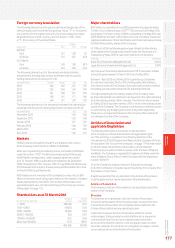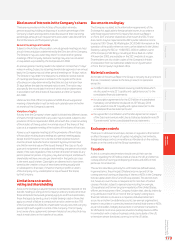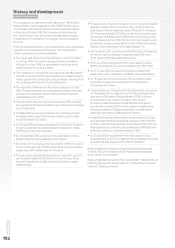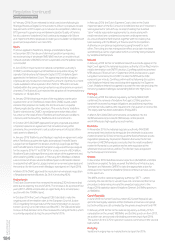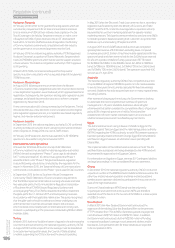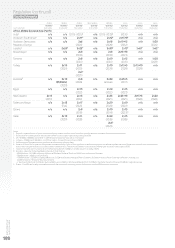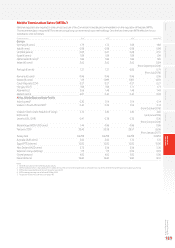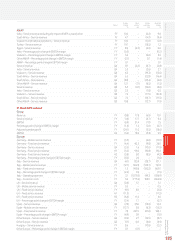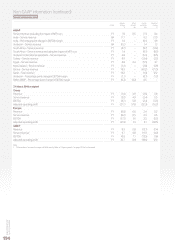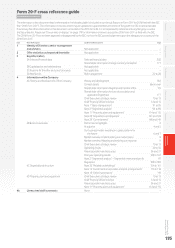Vodafone 2016 Annual Report Download - page 187
Download and view the complete annual report
Please find page 187 of the 2016 Vodafone annual report below. You can navigate through the pages in the report by either clicking on the pages listed below, or by using the keyword search tool below to find specific information within the annual report.
Overview Strategy review Performance Governance Financials
Additional
information
Vodafone Group Plc
Annual Report 2016
185
Albania
In March 2015 Vodafone M-Pesa was licensed as an e-money issuance
institution and has since been able to perform utility payments and
money transfer services for its customers.
Between April and June 2015 Vodafone Albania secured spectrum for
2x1.8MHz of 900MHz band, 2x14.4MHz of 1800MHz and 2x20+20MHz
of 2.6GHz band, allowing 4G services to be made available.
In September 2015 spectrum neutrality and reshufing in the 1800MHz
spectrum band was introduced.
Malta
In March 2014 the national regulatory authority (‘MCA’) set the MTR
at 0.40 eurocents per minute. Vodafone Malta has submitted an appeal
to the Administrative Review Tribunal on the basis that there was a lack
of transparency in the consultation process.
Africa, Middle East and Asia-Pacic region
India
In February 2012 Vodafone India challenged the Department
of Telecommunications (‘DoT’) at the Telecom Tribunal on the nancial
requirements for approving the transfer of Vodafone India telecom
licenses that were held under seven subsidiary companies to create two
telecom licensed companies – Vodafone India Limited and its subsidiary
Vodafone Mobile Services Limited. Pleadings were completed on 6 April
2016 and the next hearing is due on 19 May 2016.
In February 2015 the national regulatory authority (‘TRAI’) announced
its revised regulation on MTRs, reducing the rate from 20 paisa to 14
paisa per minute for mobile termination and nil termination for calls
originating from, or terminating on, a xed line. Vodafone India has
challenged TRAI’s decision in the Delhi High Court and the hearing
is due to commence in May 2016.
In April 2015 TRAI launched a consultation on the regulatory framework
for Over-The-Top (‘OTT’) services and Net Neutrality and the completion
of that consultation is awaited. In February 2016 TRAI issued a regulation
prohibiting the charging of discriminatory tariffs on the basis of content
or services accessed.
In March 2015 in the spectrum auction for 800MHz, 900MHz, 1800MHz
and 2.1GHz bands, Vodafone India won spectrum in all six circles
where the existing spectrum was due for expiry in December 2015,
thus ensuring continuity of business. It also won an additional 2.1GHz
spectrum in six service areas. The total auction spend by Vodafone India
was INR 258 billion.
In May 2015 the Supreme Court dismissed Vodafone India’s appeal
against the DoT’s refusal to extend its existing spectrum licences
in Delhi, Mumbai and Kolkata.
In September and October 2015 guidelines for Spectrum Sharing and
Spectrum Trading were issued respectively.
In January 2016 TRAI submitted its recommendations to the DoT on the
Valuation & Reserve price of Spectrum and DoT’s decision is expected
by the end of May 2016.
In February 2016 further to Prime Minister Narendra Modi’s allocation
of budget for the Government’s Digital India agenda, TRAI recommended
a public-private partnership (‘PPP’) “build own operate transfer” (‘BOOT’)
model as the preferred means of the implementation strategy for
BharatNet (the Government’s national optic bre network programme).
DoT’s decision on the TRAI recommendation is awaited.
In May 2016 further to a challenge by the telecom operators,
the Indian Supreme Court held that the order announced in October
2015 by TRAI, mandating MNOs to compensate customers for
any call drops, was “arbitrary, unreasonable and non-transparent”
and therefore cancelled.
For information on litigation in India, see note 30 “Contingent liabilities
and legal proceedings” to the consolidated nancial statements.
Vodacom: South Africa
In March 2014 the High Court ruled in favour of Vodacom and MTN
in their challenge to the national regulatory authority’s (‘ICASA’)
decision on Call Termination Regulations (‘CTR’). This led to ICASA
initiating another consultation process and in September 2014 they
published the nal CTR that reduces the rate to ZAR 0.13 cents per
minute by October 2016. In December 2014 Cell C served ICASA
(including other interested parties such as Vodacom and MTN) with
a notice of motion in terms of which it is seeking an order for the review
and setting aside by the High Court, of the September 2014 CTRs.
Vodacom had led a notice to oppose Cell C’s application. This matter
was due to be heard from 7 March 2016 however Cell C withdrew
its application.
In May 2014 the national competition authority (‘CompCom’)
conrmed its intention to proceed with the investigation into
an allegation by Cell C that Vodacom and MTN have abused their
market dominance in contravention of section 8 of the Competition Act.
Once the investigation is completed, the matter may be referred to the
Competition Tribunal where Vodacom will have a further opportunity
to make its case.
In May 2014 Vodacom entered into a sale and purchase agreement
under which it would acquire 100% of the issued share capital of Neotel
as well as Neotel’s shareholder loans and liabilities. The proposed
acquisition of the majority of Neotel’s assets has been abandoned due
to regulatory complexities and certain conditions not being fullled.
In September 2015 further to its International Mobile
Telecommunications (‘IMT’) Radio Frequency Spectrum Assignment
Plans (‘RFSAP’) published in March 2015 ICASA published
an Information Memorandum (‘IM’) on the prospective licensing
of the 700MHz, 800MHz and 2.6GHz High Demand Spectrum bands.
The IM is a precursor to an Invitation to Apply (‘ITA’). Vodacom has raised
its concerns that the IM does not provide sufcient detail on some of the
critical aspects of the auction design and process.
In February 2016 the Department of Trade and Industry (‘DTI’) published
the revised draft ICT Sector Code for consultation. This code follows the
May 2015 implementation of the revised generic DTI Codes on Black
Economic Empowerment (‘BEE’) which saw a complete overhaul
of the targets and requirements of the 2007 Codes, which included
the removal of the recognition of ZAR7.5 billion rule for ownership and
retention of 30% investing target that Vodacom must be compliant
with to be eligible to bid in future Spectrum auctions. The revised Codes
are expected to be nalised in June 2016 and will be applicable to the
nancial period of 1 April 2016 to 31 March 2017.
Vodacom: Democratic Republic of Congo
In December 2015 the Government ordered all operators to disconnect
any unregistered customers. In February 2016 all operators received
a non-compliance letter from the National Intelligence Agency, stating
sanctions would be applied. Vodacom DRC is suspending customers
with insufcient registration records and communicating to such
customers the requirement to register to avoid disconnection. To date,
no sanctions have been imposed.
In September 2015 the national regulatory authority (‘ARPTC’) retained
the current on-net voice price oor at 5.1 US cents per minute and
off net 8.5 US cents per minute set in March 2015 and extended the
price oor to cover international outgoing calls and promotions until
June 2016.
In December 2015 Vodacom Congo’s 2G licence was renewed with
a ten-year extension taking the expiry date to 1 January 2028, together
with securing additional spectrum 2x5.8 1800MHz and 1x15 1900MHz.
Collectively, the licence and spectrum fees paid was US$22.5 million.




